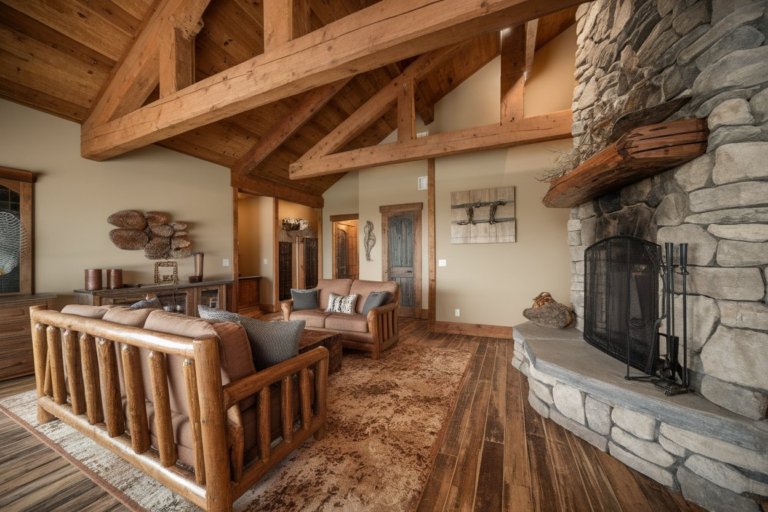22 Home Office Ideas for Two People
Working from home has become a staple in modern life, and if you’re sharing a space with a partner, friend, or colleague, setting up a productive yet comfortable home office becomes even more essential.
The key to a successful shared home office lies in making the space functional, comfortable, and inspiring without stepping on each other’s toes.
In this guide, I’ll walk you through 22 creative and practical ideas for designing a home office for two people, tailored to various needs, preferences, and available space.
1. Embrace Separate Workstations
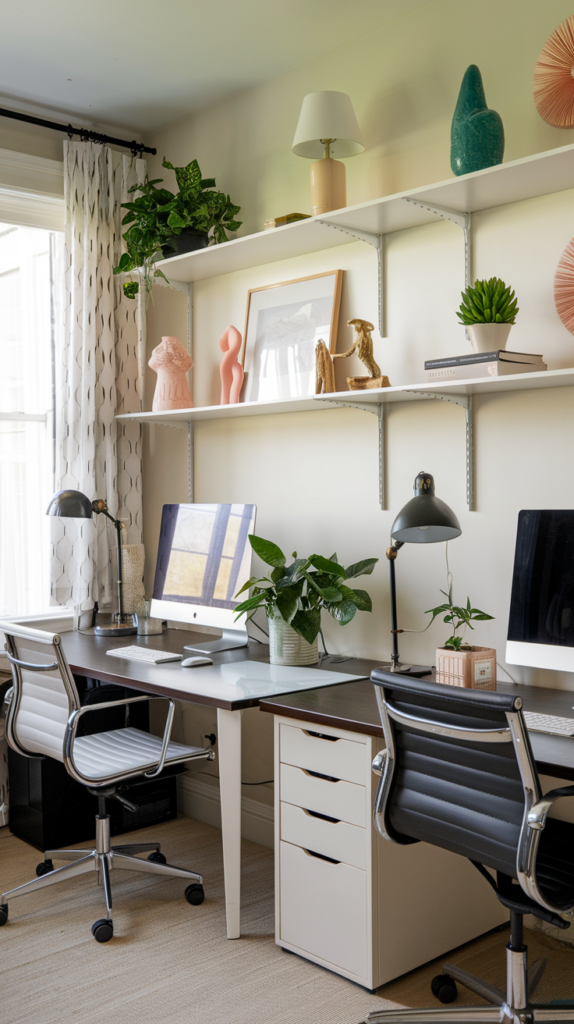
A shared office doesn’t mean sharing the same desk. In fact, creating separate workstations can help you maintain focus and reduce distractions. This can be as simple as placing two desks across from each other or, if space allows, in opposite corners of the room. By providing each person with their own dedicated workspace, you create boundaries and encourage a sense of ownership.
Consider ergonomics—think adjustable chairs and standing desks to maintain comfort throughout long work hours. With separate workstations, each person can curate their desk setup to their own style and needs, from technology to decor.
2. Use Vertical Storage Solutions
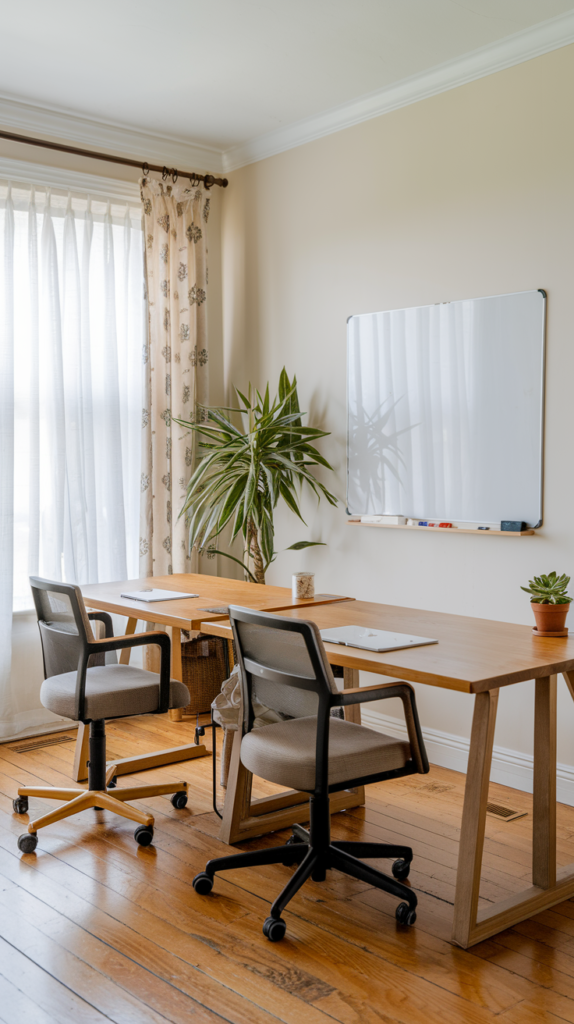
When working with limited space, don’t forget to think vertically. Wall-mounted shelves or floating bookshelves can house documents, office supplies, or even plants. Vertical storage doesn’t just help organize your space;
it makes it feel less cluttered. This is especially important when two people are sharing the same room. By freeing up desk space with vertical solutions, you ensure each person has a tidy and organized environment, helping both of you stay productive.
3. Color Coordination for Harmony
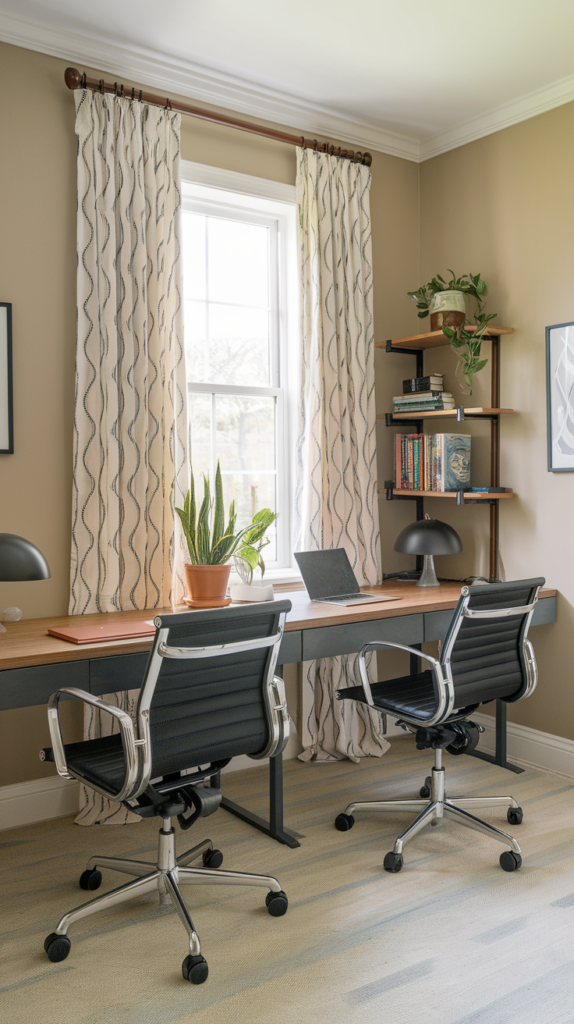
Color plays a huge role in how we feel in a space. When creating a home office for two, a color palette that balances both people’s preferences is key. A soothing, neutral base color can create a calm atmosphere, while pops of color—perhaps a bright accent wall, vibrant accessories, or colorful desk items—add personality and energy to the room.
If one person prefers bold hues while the other likes more subtle tones, find a way to merge the two styles cohesively. A good example could be neutral walls with bright furniture or décor to create a space that feels alive yet peaceful.
4. Define Personal Zones with Rugs
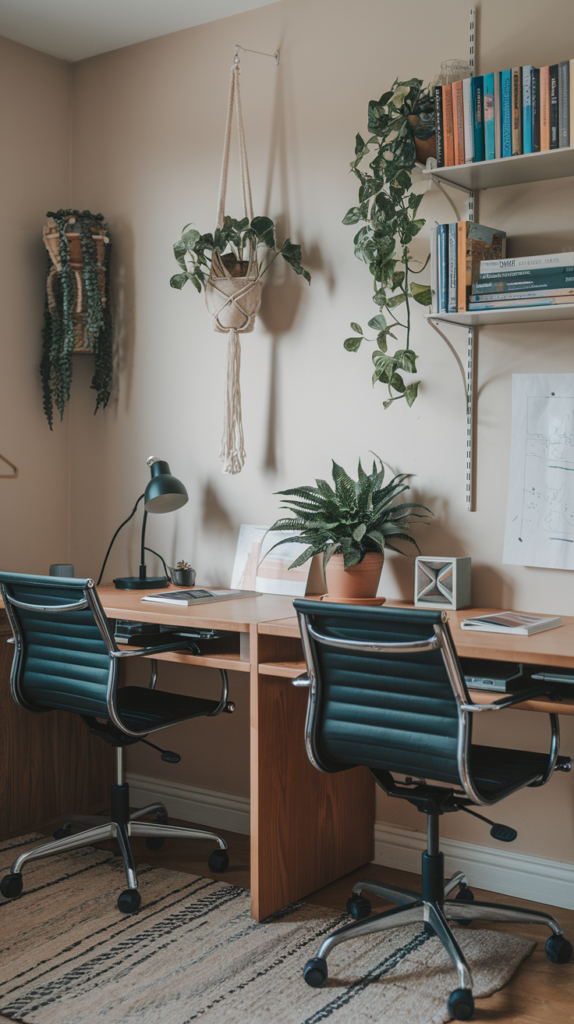
Rugs are not only functional but also decorative. By using rugs to define each person’s zone, you create a subtle visual boundary while maintaining a sense of cohesiveness in the space. Rugs can add warmth and texture, making the office feel more inviting. If you both work in different areas of the room, placing individual rugs under each desk can create clear work zones and help organize the space without using walls or heavy partitions.
5. Partition with a Folding Screen
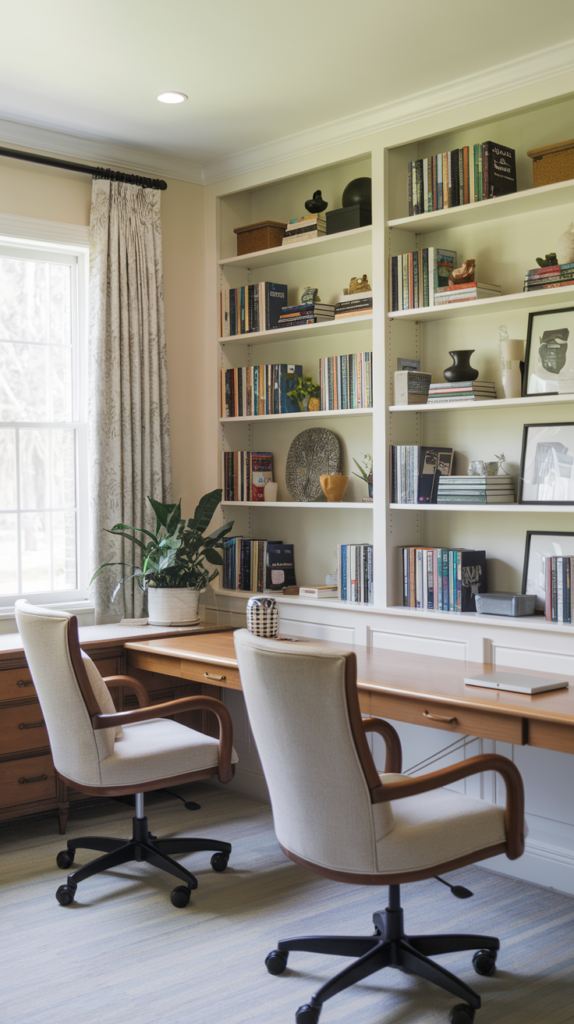
If you want some separation without committing to permanent changes, folding screens are an excellent option. These versatile partitions can be moved around as needed and provide privacy during work hours. Whether you prefer a minimalist design or a bold pattern, a folding screen allows you to segment the space without making it feel cramped. It’s an easy and affordable way to create distinct areas within your shared home office.
6. Invest in Dual-Desk Setup

When it comes to working together, a dual-desk setup might be the perfect solution. This idea is perfect for couples, business partners, or even close colleagues who want to collaborate while keeping their workstations separate.
Dual desks placed side by side, facing each other, or even in an L-shape, offer ample space for both individuals. Plus, it promotes teamwork since you can easily share documents or brainstorm ideas. The key to making this work is ensuring each desk is equipped with everything needed for productivity, from tech gadgets to task lighting.
7. Clever Cable Management
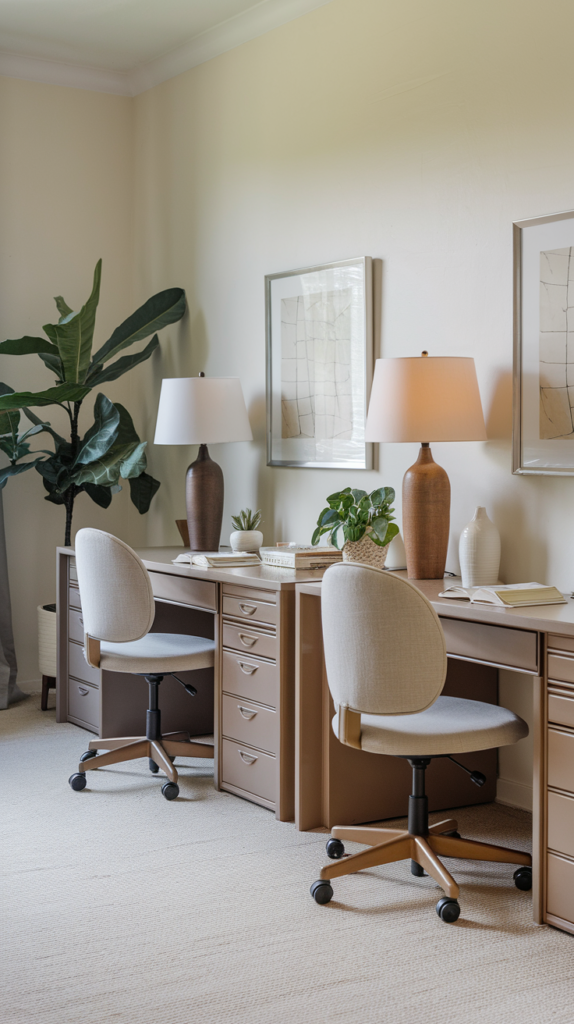
Shared workspaces often come with a tangled mess of cables, chargers, and wires. Keeping everything organized and tangle-free should be a priority. Invest in cable organizers, clips, and sleeves to keep cords from becoming a disaster.
Not only does it look cleaner, but it also prevents the annoyance of tripping over cables or unplugging the wrong device. Clever cable management is crucial in any home office, especially one shared by two people.
8. Get Comfortable with Ergonomics
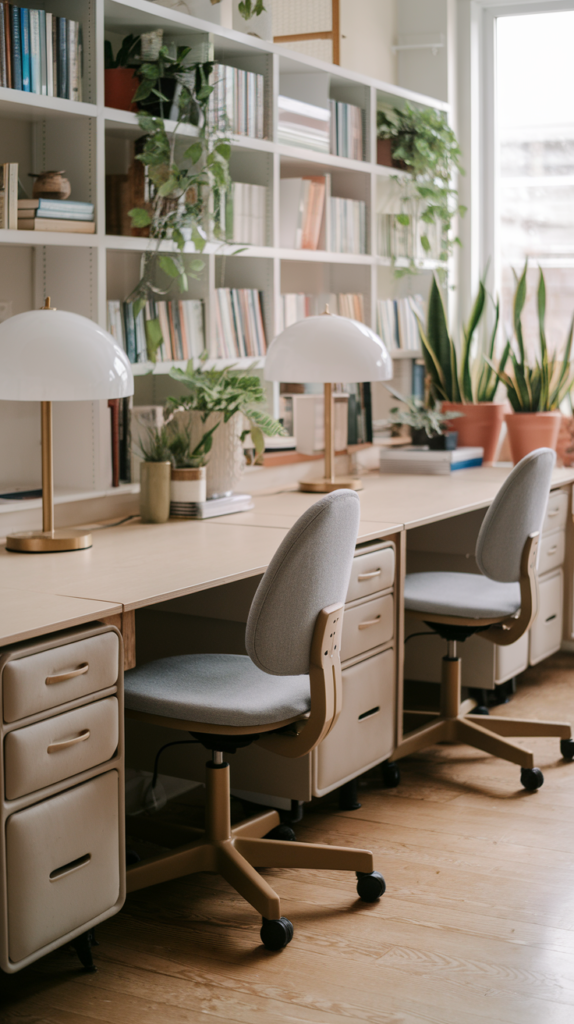
One of the most important aspects of any office setup is ergonomics, and when you’re working together, it’s essential to consider each person’s comfort. Both people in a shared office will likely need different things from their chairs, desks, and computer setup.
Adjustable chairs with lumbar support, sit/stand desks, and monitor risers are a great starting point. Invest in ergonomic accessories like keyboard trays, wrist rests, and footrests to ensure a comfortable work environment that promotes productivity and minimizes physical strain.
9. Choose Multipurpose Furniture

In a home office shared by two, furniture needs to be functional and adaptable. Consider investing in multipurpose furniture that can serve dual functions, like a desk with built-in storage, a chair that doubles as a guest seat, or a modular shelving unit. This approach helps maximize the space while keeping everything accessible. Look for furniture that offers flexibility—this way, you can rearrange or upgrade it as your needs evolve over time.
10. Bring Nature Indoors with Plants
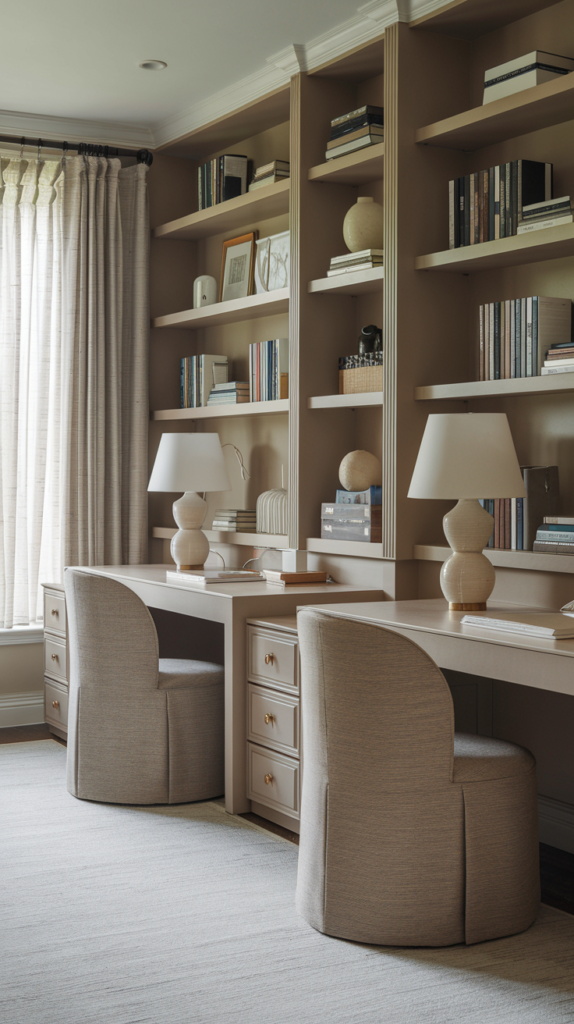
Plants are a fantastic way to improve the ambiance of any office space, and they’re especially effective in a shared environment. They purify the air, reduce stress, and create a calming atmosphere. Add a variety of plants like succulents, hanging plants, or even a small indoor tree to make the office feel more inviting and peaceful. Plus, each person can take ownership of their own plant, turning it into a personal touch. The greenery will bring the space to life and create a collaborative, fresh vibe.
11. Separate Lighting for Each Desk

Lighting is crucial for productivity, and in a shared space, having individual lighting options for each person can prevent disagreements. Task lighting, like adjustable desk lamps, allows each person to control the brightness and direction of their light.
You can also experiment with different types of light—cool lighting is great for focus, while warm lighting is better for relaxation and mood-setting. This small addition can make a huge difference in how each person feels throughout the day.
12. Personalize Your Workspace
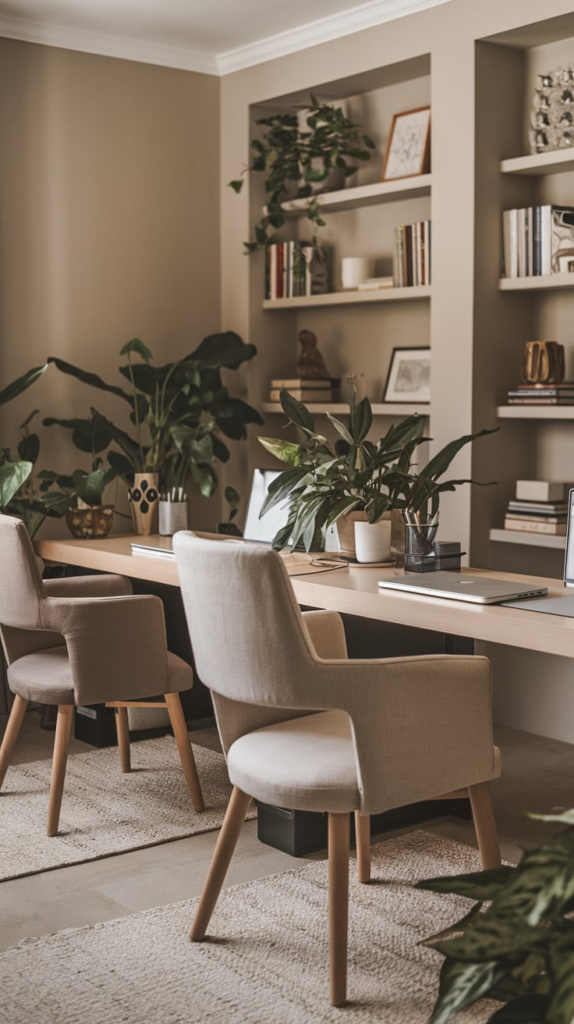
Even when you’re sharing an office, there’s no reason why you can’t personalize your workspace to reflect your style. Each person should be able to customize their side of the office with items that inspire them.
From framed photos to motivational quotes, personal knick-knacks, and favorite books, these details can make a workspace feel more welcoming. Personalized spaces enhance comfort and happiness, which in turn boosts productivity.
13. Optimize for Collaboration
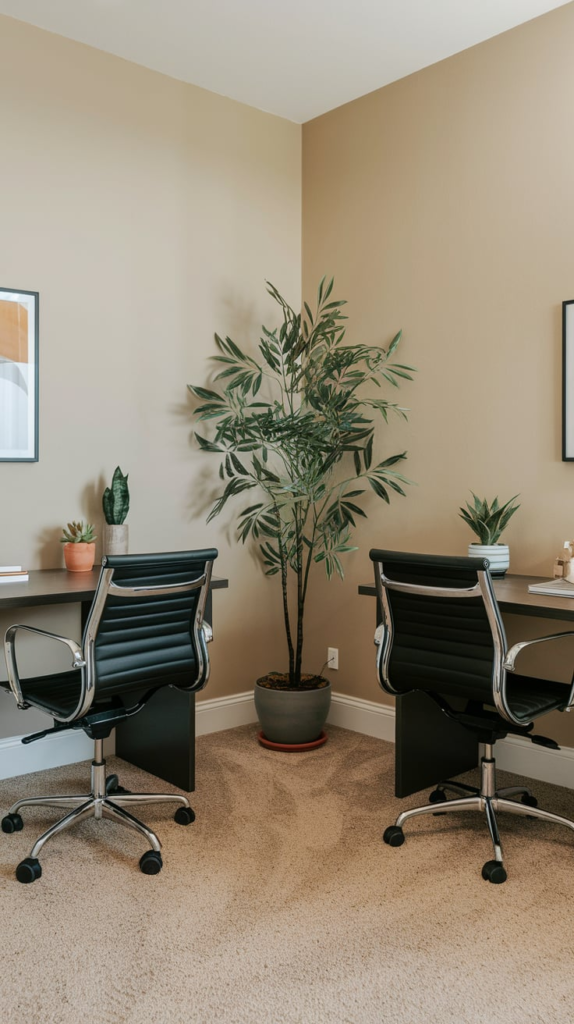
While it’s important to have personal workstations, you should also design the space for collaboration. Create a small meeting area or a comfortable spot for brainstorming sessions. This could be a small round table, a cozy corner with lounge chairs, or a whiteboard wall for sketching out ideas. This approach encourages teamwork and gives you a designated area to discuss ideas without disrupting your individual workflow.
14. Make Use of Natural Light
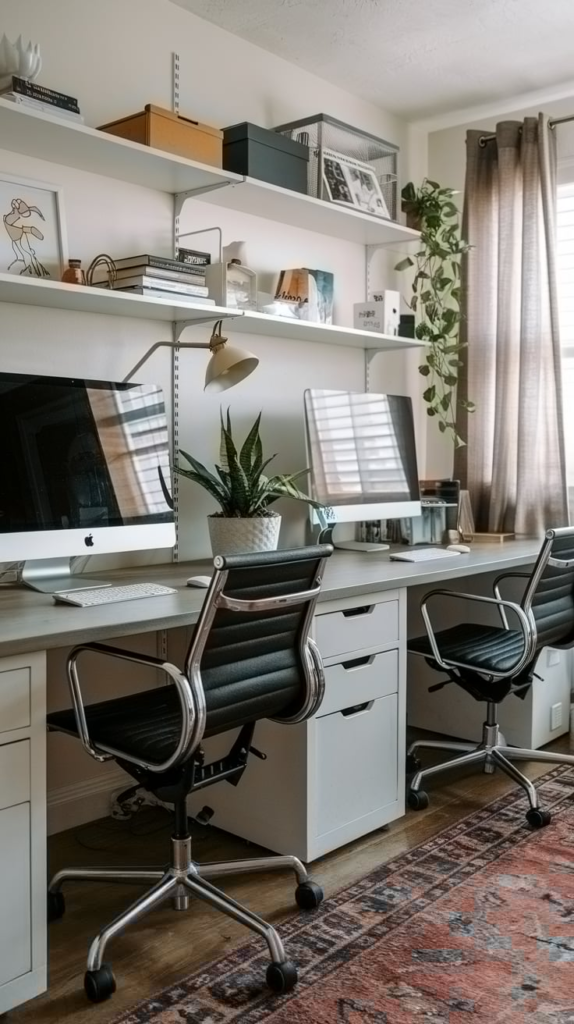
If your home office has windows, take full advantage of natural light. Studies show that exposure to natural light increases productivity and overall well-being. Position desks near windows if possible, or use light curtains that allow sunlight to filter through. If your office doesn’t get much natural light, consider investing in full-spectrum lighting that mimics sunlight to brighten up the space and reduce eye strain.
15. Soundproof Your Office
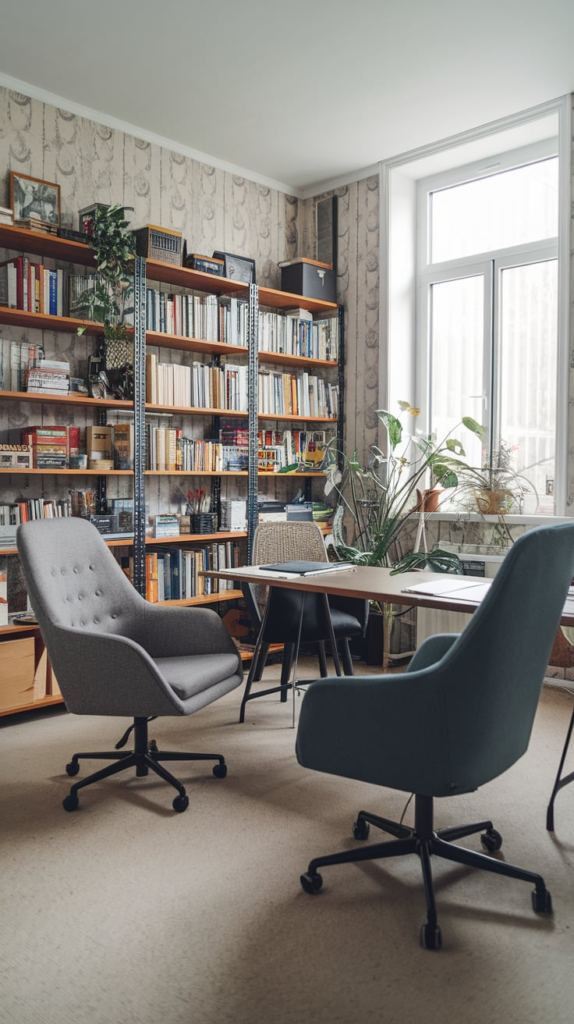
Noise can be a big issue in a shared office, especially if you’re working with different schedules or noise levels. If you can, soundproof the room by adding thick curtains, rugs, or acoustic panels. A soundproof space allows each person to focus on their work without distractions. Additionally, noise-canceling headphones are a lifesaver in a shared office, as they allow each person to block out unwanted sounds while working.
16. Create Clear Boundaries for Breaks
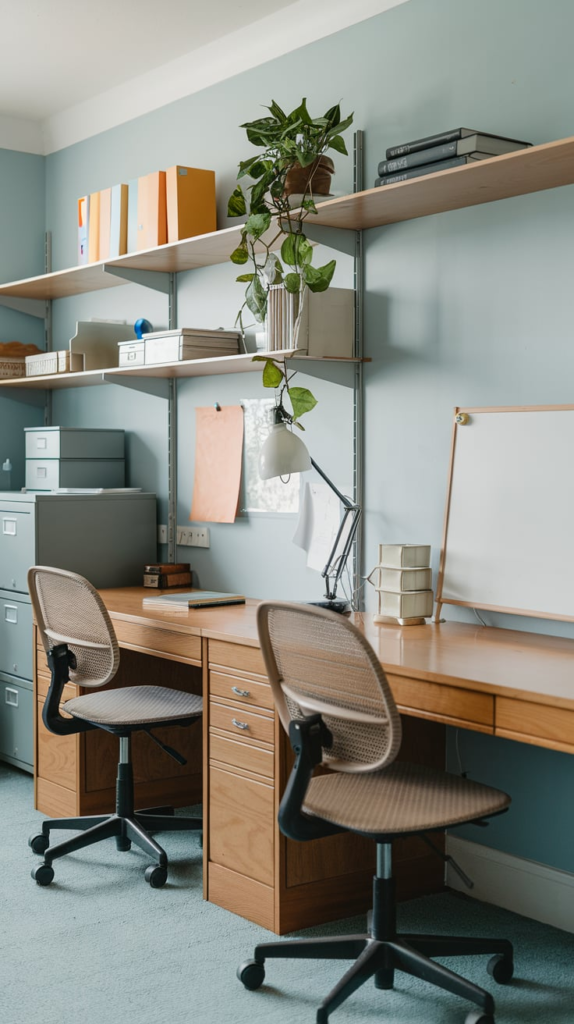
When sharing an office, it’s easy for work and personal time to blur together. To avoid burnout and ensure both people have the space they need to recharge, establish clear boundaries for breaks. Consider adding a small area in the office with comfortable seating where one person can take a break without interrupting the other. Use this zone for relaxation, coffee breaks, or catching up on personal tasks, ensuring a healthy balance between work and downtime.
17. Invest in Technology

Technology is at the heart of any modern home office, especially when two people are sharing the space. Make sure you’re equipped with high-quality computers, reliable Wi-Fi, and enough power outlets to accommodate all your devices. Think about investing in shared resources like a printer, scanner, or storage solutions that both people can access. When technology works seamlessly, it allows you both to focus on your work without interruption.
18. Plan for Future Needs
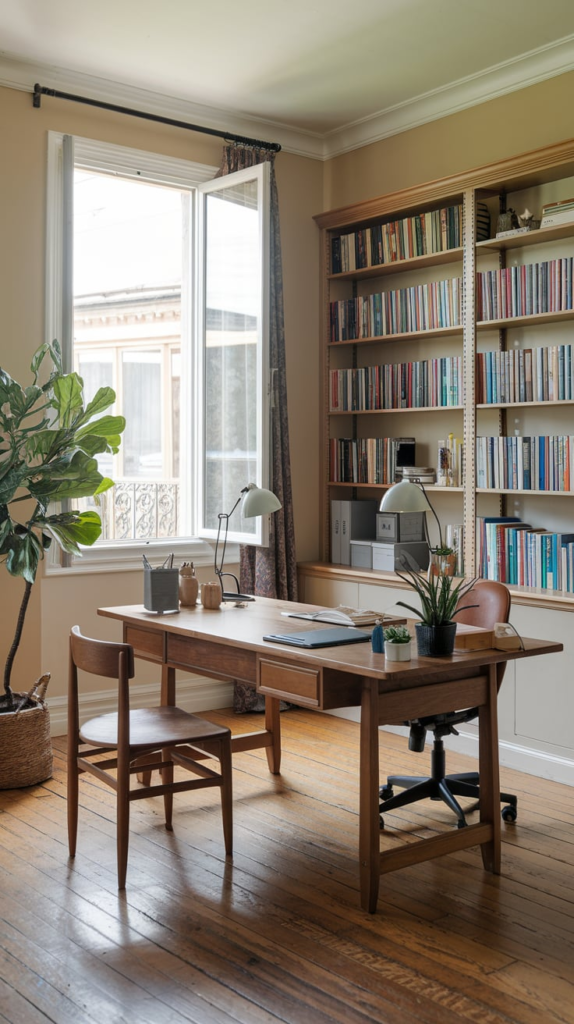
A shared home office should be adaptable, which means planning for future needs. Whether you’re expecting to expand your team, need additional storage space, or anticipate changes in your work schedule, design the office with flexibility in mind. Modular furniture, movable partitions, and easily rearrangeable desks are great for adapting to future needs. Planning ahead will make sure the space evolves with your requirements without causing clutter or frustration.
19. Choose a Quiet Color Scheme

When designing a shared home office, a calming color scheme can make all the difference in reducing stress and promoting focus. Opt for neutral tones like whites, grays, and soft blues, paired with small accents of color to keep the space feeling fresh. A quiet color palette fosters concentration and minimizes distractions, ensuring that both people can maintain their focus throughout the workday.
20. Incorporate Functional Decor

Décor is more than just aesthetic—it can serve a functional purpose. Consider incorporating décor items that enhance productivity, like a large wall calendar to keep track of deadlines or a bulletin board to display important notes. Similarly, stylish storage containers or baskets can keep office supplies organized while adding a decorative touch to the room. Functional décor ensures the office looks good while staying practical for day-to-day use.
21. Create a Shared Inspiration Wall
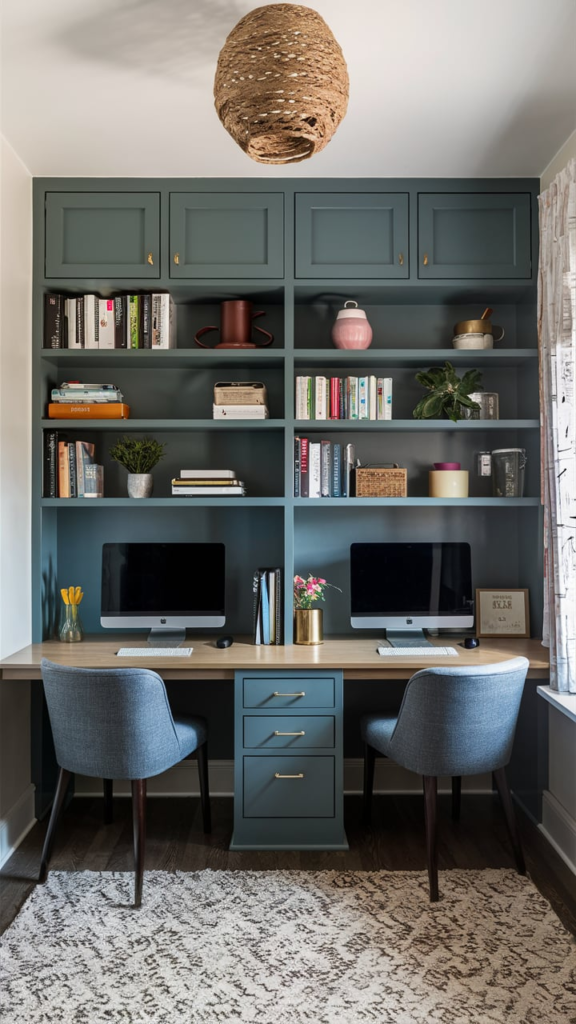
Inspiration plays a key role in maintaining motivation, so why not create a shared inspiration wall? This could be a corkboard or a magnetic wall where both people can pin up their goals, vision boards, or motivational quotes. This collaborative space encourages creativity and helps maintain focus throughout the day. A shared inspiration wall fosters a sense of teamwork and common purpose, which is crucial in a dual-office setup.
22. Maintain Flexibility in Layout
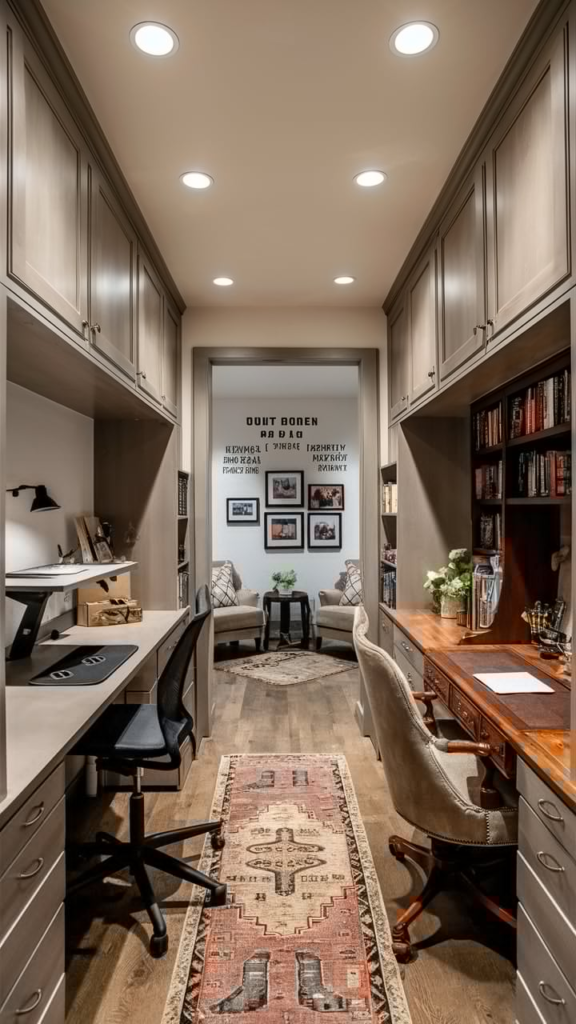
Lastly, flexibility is essential in a shared home office. Being able to easily change the layout according to different needs can keep the workspace feeling fresh and accommodating. Whether you’re working on a collaborative project or need some alone time to focus, a flexible layout allows you to adjust the office to suit your current tasks. Consider furniture on wheels, adjustable desks, and mobile storage units to keep things dynamic and adaptable.
conclusion
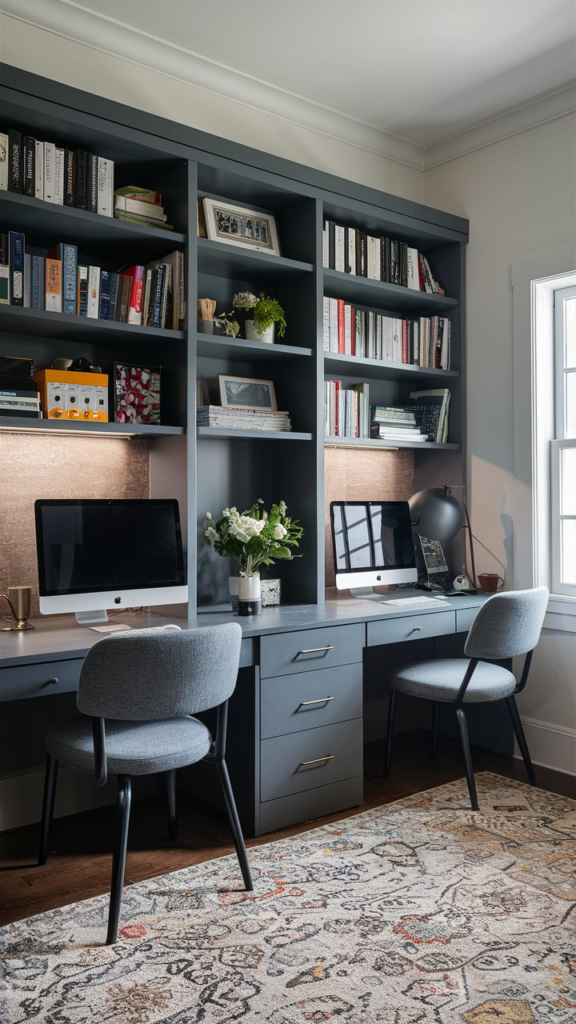
Designing a home office for two people requires thoughtful planning and attention to detail. By considering ergonomics, personalization, collaboration, and future needs, you can create a functional and inspiring space where both individuals can work efficiently and comfortably. Whether you’re sharing an office with a partner, colleague, or friend, these 22 ideas will help transform your workspace into a productivity powerhouse.



